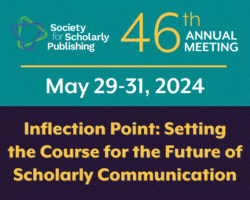Paula Stephan will open the meeting with an evening keynote address discussing the challenges of entering a career in research. Stephan is one of the two keynote speakers at this year’s Society for Scholarly Publishing (SSP) Annual Meeting in Boston, May 31 to June 2. She kindly agreed to answer a few questions about her important research on the careers of scientists and engineers, as well as her own long and distinguished career.
Whether or not you’ll be at SSP, this interview provides a fascinating glimpse of Stephan’s work and highlights some of the broad themes she will be addressing in her talk.
You’re currently Professor of Economics and Senior Associate, Policy Research Center, Georgia State University – can you tell us a bit about your main areas of focus in these positions?
I retired from Georgia State about ten years ago—benefitting from a defined benefit retirement system—and was hired back part time in employment beyond retirement. This has allowed me to continue to be connected and contribute to a department and college that I care deeply about, but also to explore alternatives, such as take visiting positions at the University of Torino, Max Planck Institute in Munich, Harvard University, and KU Leuven, as well as serve on numerous National Academy committees. I also have been a member of the board of Reviewing Editors for Science for the past five years.
You have a very impressive CV! What are the main threads that run through your career, and why did you choose to focus on these areas?
My research is primarily focused on the careers of scientists and engineers, the role of mobility in science, funding for research and the broader issue of how knowledge is transmitted in our society. It is a roundabout story as to how I came to doing research in this multidisciplinary area. Here goes!
I was trained as a labor economist at the University of Michigan with a focus on human capital. My research initially was theoretical and focused on the shape of earnings over the life cycle. In the late 1970s I began collaborating with a classmate from Michigan, Sharon Levin, on a project that looked at the gender composition of fields in science, with the underlying hypothesis being that women chose fields that were less subject to obsolescence. This began a collaboration that lasted over 35 years. Soon after we began work on this project, a National Science Foundation project officer challenged me to think about the question of whether science was a young person’s game. His rationale was that the US research workforce at universities was aging and if science were, indeed, a young person’s game, the scientific edge of the US was being threatened. The belief, as you may know, was common among scientists—especially physicists. To quote Dirac, “Age is of course a fever chill / That every physicist must fear / He is better dead than living still / When once he’s passed his 30th year.”
We began to think about doing research in the area. The challenges were formidable in the sense that it is difficult to distinguish what we would call aging effects from cohort effects. To be more specific, a scientist’s productivity can relate to life cycle events, such as those related to incentives as well as physiological processes, but it can also reflect events related to their cohort, such as job market effects (think of what happened to individuals coming of scientific age during the most recent financial crisis) or changes in theory or techniques. Isolating aging effects is thus quite challenging econometrically and at a minimum requires longitudinal data where one follows individuals over time. NSF at the time collected such data (the SDR) but no one had had access to use it at the individual level and it had never been matched to publication records. It is a long story, but, after three funding attempts, we were finally funded to work on the project and to match the NSF data (the SDR) to publication data. We rapidly realized just how much we had to learn, not only about econometric issues, but about the practice of science and labor markets in science and we began reading extensively outside our field as well as interviewing scientists. Our research suggested that there was a relationship between age and productivity for exceptional research, and that it was field dependent. It also convinced us that cohort effects play a role in science. Our results were published in places such as the American Economic Review as well as a book, Striking the Mother Lode in Science: The Importance of Age, Place and Time.
The next major research project that Sharon and I took up was to study the birth and educational origins of individuals making exceptional contributions to science.
Soon after this research was completed, I was invited to serve on a committee of the National Academy that Shirley Tilghman was chairing, “Trends in the Early Careers of Life Scientists.” The year was 1996. The invitation was based in part on my knowledge of the NSF data. This marked a watershed for me in the sense that it was the first time I worked on a national committee where I was one of the few social scientists and the majority of the members were research faculty in science. I learned a great deal about career issues, especially of young scientists, from this experience as well as a considerable amount about the way in which university labs function and are funded. This proved to be the first of many experiences I have had serving on committees populated primarily by scientists. I always learn a great deal from participation in such committees. For example, I have also served on the Advisory Council for NIGMS at NIH, the NAS committee to Revisit the Postdoctoral Experience and currently I serve on the Next Generation Committee for the Academy. There are something like ten other committees that I have not mentioned including several related to the European Research Council.
My research has led me to become increasingly aware of how incentives and costs affect the practice of science. This led me to write the book How Economics Shapes Science, Harvard University Press, 2012. My family refers to the book as the ”Mouse” given that the cover shows a mouse made out of $100 bills. The book has now been translated into Korean and Chinese and a portion of it into Japanese.
My research on careers and mobility has continued. For example, about seven years ago I began working with two Italian colleagues on a study of international mobility of researchers from 16 countries, referred to as the GlobSci project, in which we collected data on approximately 19,000 scientists working in four fields. We have also studied how submission patterns to top-rated journals, such as Science, respond to incentives. Most recently I have been working with coauthors from Belgium on the topic of how short-term bibliometric measures tend to be biased against novel research and thus discourage panels from funding risky research. This research was featured recently in a commentary by us in Nature: “Blinkered by Bibliometrics.”
The careers of scientists and engineers is a recurring theme in your work, and one which is of particular interest to SSP members. Have you seen significant changes in the challenges and opportunities for scientists and engineers during your own career?
Yes, there have been some substantial changes. First, and foremost, and especially in the biomedical sciences, academe is now the alternative career path. Second, funding has become increasingly difficult to get but increasingly important to researchers and also to the way in which universities are structured. Third, bibliometrics play a much larger role in the careers of scientists and scientists are increasingly aware of them. Postdocs are incredibly aware of their need to be a first author on a major publication if they wish to have any chance of landing a tenure-track position.
There are also new ways of doing research that a previous generation did not have—such as outsourcing, opportunities to work with core equipment, and increased possibilities for collaboration across campuses and countries.
On the other hand, some things remain the same. First, scientists continue to be affected by changes in the economic climate. For example, during the IT buildup, fewer and fewer individuals went on for a PhD in the physical sciences. Then the “bust” came in the early 2000s and PhD enrollment grew. Or consider what happened to postdocs in engineering when, during the crisis, they grew from 30 percent of those with definite commitments to 45 percent of those with definite commitments upon graduation.
Do early career researchers in these fields face different challenges and opportunities than their more established colleagues?
Absolutely! First and foremost is the challenge of finding a research position, be it in academe, government or industry. Especially in the biomedical sciences, the prospects of such a position have declined considerably overtime. Second, and assuming one does get such a position in academe, is the extraordinary pressure to bring it funding so that one can continue to be employed in academe. The age at first grant has increased significantly over time. Third, it is especially hard for younger researchers to renew their funding.
There’s pretty sound evidence that in science and engineering, as in many other disciplines, there’s a lack of diversity especially at the top. As a woman and a leader in your field, do you have any advice for young women and minority researchers?
At the time I got my PhD in economics, fewer than 10 percent of recipients were female. Today it is close to 35 percent so I have witnessed considerable change. I am fortunate in that I work in a department that for many years has had a substantial number of women faculty members. But things were not always this way. I clearly remember having the chair explain to me, without any hint of embarrassment, that I would get two-thirds of the holiday bonus that men in the department were getting!
Despite the progress that women have made, I am continually amazed to go to national and international forums and find myself in the minority…indeed, often the distinct minority.
Advice? I think finding a mentor is extremely important. In the Economics profession, there is a program to do precisely this and I think it has been quite successful. Second, a sense of humor helps a great deal in tough situations. Third, it is important to ask. One of the things that holds women back is an inhibition with regard to asking. If you don’t ask the chances are much lower that one will receive.
How would you sum up the current state of science and engineering research careers in one sentence?
Exciting but extremely challenging in terms of establishing a viable research career in many, but not all, fields.
Last but not least, can you give us a sneak preview of what you’ll be talking about at the SSP conference?
My preliminary plans are to talk about challenges that recently minted PhDs in science and engineering face in establishing a research career. The discussion will include economics underlying the postdoc position as well as the important role that publications play in early careers and more generally in funding for research.



Join the Conversation
You must be logged in to post a comment.